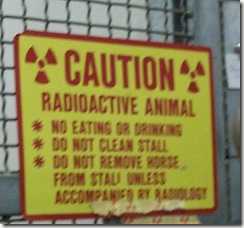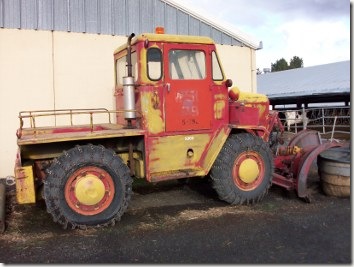 For the last couple of months, I’ve been taking the Livestock Advisor course that’s sponsored by Washington State University. The concept of the course is to get a broad overview of training about all types of agricultural livestock; and then to give back to the community by sharing this information in a variety of volunteer opportunities. I’m enjoying the courses, though they are a bit more basic than I’d hoped. But, you always pick up something from a class, and I’ve learned a few new things.
For the last couple of months, I’ve been taking the Livestock Advisor course that’s sponsored by Washington State University. The concept of the course is to get a broad overview of training about all types of agricultural livestock; and then to give back to the community by sharing this information in a variety of volunteer opportunities. I’m enjoying the courses, though they are a bit more basic than I’d hoped. But, you always pick up something from a class, and I’ve learned a few new things.
Last week, we traveled to WSU to do a whirlwind tour of all of their agricultural facilities.
It was a fun trip. We toured the school of veterinary medicine, where we saw a radioactive horse (this was, I believe, a “pet” horse being treated at the hospital, using a radioactive material, such that he had to be labeled with the above curious signage). There was a cannulated (or fistulated) cow- fitted with a permanent “cork” in her side that could be opened to access her rumen. This is done for study, as well as to “borrow” microbe-rich rumen juices from her to inoculate a sick cow that is lacking in healthy rumen activity. It’s bizarre, but harmless, cows can live a normal life with a fistula. This girl is doing a lot for animal health research, and also her fellow ruminants who visit the hospital for treatment; all while living a pampered life at the vet school.
In the vet school building, there is a fun room full of biological models (made from real live specimens) used for students to study anatomy. It’s a decades-old collection of artistically preserved and meticulously color-coded and labeled illustrations of skeletons, muscles, stomachs, brains, intestines, and the like. Much better than a textbook for helping students learn, in their quest to spend their careers helping animals. Here’s a whole cow, in the foreground, with lots of studies of limbs in the background:
The cutest one was this little mouse; I have a hard time imagining how tedious he must have been to reassemble!
 WSU has a really impressive compost facility, which recycles much of the waste generated by the entire university. All of the regular stuff you’d expect goes there- manure and animal bedding, landscaping debris, and dining center food waste, including a lot of kitchen cups and utensils made from biodegradable materials (not all of which, we learned, is truly biodegradable, and is the bane of the compost facility managers!).
WSU has a really impressive compost facility, which recycles much of the waste generated by the entire university. All of the regular stuff you’d expect goes there- manure and animal bedding, landscaping debris, and dining center food waste, including a lot of kitchen cups and utensils made from biodegradable materials (not all of which, we learned, is truly biodegradable, and is the bane of the compost facility managers!).
Because they process such a large volume, they use a much more sophisticated system than a “home compost” would. The material is piled in windrows, which have a perforated pipe at the bottom. The pipes are connected to a huge compressor, which creates a “negative pressure” system that pulls air down through the piles to oxygenate and dry them, and encourage rapid microbial breakdown. The compressor, baffles inside the pipes, and temperature probes are all hooked up to a laptop computer, which is used as a command center to control the airflow through each windrow and monitor its temperature and performance. Here’s the backside of a row of compost piles in varying stages of decomposition:
In addition to the usual inputs, they process a lot of surprising stuff too- wood of all types (pallets, excess lumber etc) which is ground up by a giant grinder; and the animal carcasses that are the byproduct of the vet school. You see, vet schools always take on the toughest medical cases, and though they have a lot of miraculous successes, unfortunately not every case that’s referred there has a happy ending. The reality of Mother Nature is that sometimes an animal dies, maybe a very large animal, and it needs to go somewhere! ;-P Amazingly, these compost piles are so well managed, they can process a large animal in a matter of weeks! Apparently, that includes all but the largest bones even! So, though it’s not the most pleasant thing to consider, it’s reality, and at least with composting, the bodies are recycled and put to good use. Sensitive to the sensibilities of potential onlookers, such deceased are transported in a closed truck, which arrived just in time for our tour! 😀
Lest you think there might be disease or bacteria risk from the cafeteria food and animal veterinary waste- the piles are turned frequently, and the temperatures monitored very carefully; so that it’s ensured that all portions of the piles are brought up to sufficient temperature to kill any harmful bacteria or virus, many times over. So, it’s considered a very safe and practical thing to do with the inevitable “output” that any veterinary hospital generates, as well as any student dining hall! In fact, it’s now the method recommend by most experts for dealing with agricultural animal losses at home on the farm as well (depending on the capability of your compost system, and local laws, of course).
Once the composting process is finished, the result is beautiful, sterilized, and nutrient-rich loamy soil. This soil is sold to individuals, plant nurseries, and sent back to all of the agricultural facilities on campus to be used as animal bedding. So, much of it cycles back and forth between places like dairy cow stalls and the compost facility, resulting in the ultimate in efficiency and reduction of waste and fuel consumption! Most impressive!
An interesting discussion ensued regarding something that has been learned by the compost industry in recent years, and WSU in particular, since they are one of the forerunners of a large-scale compost operation and often learn the “hard way” how to do what nobody else has done before. And that is the issue of herbicide residue in compost that gets there via animal manure. It turns out that some broadleaf weed killers applied to pasture forage does not break down very fast. And since those herbicide types are only fatal to broadleaf plants, they can be absorbed into growing grass, which can then be consumed by grazing animals, which then pass the herbicide on in their manure. If this manure is processed into compost, the herbicides may not be destroyed by the high temperatures in the compost process, and could still be there when it’s eventually used with the intent to fertilize nursery and greenhouse crops, like tomatoes. Tomatoes don’t like being grown in soil that has broadleaf killer in it! :-0 So, now we know: it’s important to always question the providers of manure to be used for fertilization or composting: could the animals have been grazed on, or eaten hay from, pastures where broadleaf herbicides were used in the past year or so? WSU is careful where they get their manure in the first place, and they test, test, test all of their compost now to prevent this from happening in their products.
We also toured the swine facility and saw lots of cute piglets, the beef cow operations at both WSU (Angus and Wagyu cows) and University of Idaho (Charolais cows), the dairy (Holsteins), the meat animal lab, the sheep center at U of I, and I can’t remember what else! Here is a little dairy cow calf peeking her head through a feeder box to say hello and see if we had any treats for her!
 I enjoyed seeing the setup at the sheep center, and particularly admired their “jug” design in the lambing barn, which was bright and airy from a clear-plastic roof design. These looked like home-welded metal frame panels with hogwire on the inside; and the tops of the vertical hogwire rods were each turned into a loop to prevent anything catching on them.
I enjoyed seeing the setup at the sheep center, and particularly admired their “jug” design in the lambing barn, which was bright and airy from a clear-plastic roof design. These looked like home-welded metal frame panels with hogwire on the inside; and the tops of the vertical hogwire rods were each turned into a loop to prevent anything catching on them.
 And, lastly, for fun- we visited the WSU surplus equipment barn and checked out all the interesting stuff for sale. A university generates an amazing amount of stuff, a lot of it very old! Mountains of computer extras, band uniforms, chemistry beakers, furniture and everything in between! And they continue to use some things that have been around a while too. At the dairy barn, we saw this relic, still in good repair and constant use in the winter: a World War II snow plow! 😀
And, lastly, for fun- we visited the WSU surplus equipment barn and checked out all the interesting stuff for sale. A university generates an amazing amount of stuff, a lot of it very old! Mountains of computer extras, band uniforms, chemistry beakers, furniture and everything in between! And they continue to use some things that have been around a while too. At the dairy barn, we saw this relic, still in good repair and constant use in the winter: a World War II snow plow! 😀




